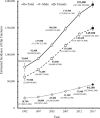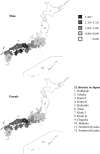Trends in Hip Fracture Incidence in Japan: Estimates Based on Nationwide Hip Fracture Surveys From 1992 to 2017
- PMID: 33615101
- PMCID: PMC7872333
- DOI: 10.1002/jbm4.10428
Trends in Hip Fracture Incidence in Japan: Estimates Based on Nationwide Hip Fracture Surveys From 1992 to 2017
Abstract
As of 2015, the aging population in Japan was the largest in the world. Although the National Database of Health Insurance Claims (NDB) was developed in 2012, long-term trends regarding hip fracture incidence in Japan remain unclear. In order to clarify the trend in hip fracture incidence from 1992 to 2017, we estimated the number of new hip fractures in 2017, the seventh in a series of nationwide hip fracture surveys performed every 5 years since 1987. We also investigated regional differences in hip fracture incidence. We collected data through a nationwide mail-in survey of orthopedic institutions in Japan and calculated hip fracture incidence by sex and age, as well as standardized incidence ratio (SIR) across 12 districts. The total number (95% confidence interval) of hip fractures in 2017 was estimated at 193,400 (187,300-199,500), occurring in 44,100 (42,700-45,500) males and 149,300 (144,500-154,100) females. Of all the hip fracture surveys from 1992 to 2017, the 5-year hip fracture increase rates from 2012 to 2017 was the lowest among female patients. In males, the 5-year rates from 2012 to 2017 were lower than those from 2007 to 2012. The age-adjusted incidence rates for patients in both sexes did not show significant change in the 25-year period. The estimated incidence rates in 2017 for patients aged 70 to 79 years in both sexes were lowest from 1992 to 2017, and declined significantly over the 25-year period. SIRs differed between northeast and southwest regions. Our findings were similar to those from a previous study in Japan using the NDB from 2012 to 2015. Progress in the development of osteoporosis medication may contribute to the continuous decline in the 70-year to 79-year age group. © 2020 American Society for Bone and Mineral Research © 2020 The Authors. JBMR Plus published by Wiley Periodicals LLC on behalf of American Society for Bone and Mineral Research.
Keywords: AGING; HIP FRACTURE INCIDENCE; JAPAN; OSTEOPOROSIS.
© 2020 The Authors. JBMR Plus published by Wiley Periodicals LLC on behalf of American Society for Bone and Mineral Research.
Figures
Similar articles
-
Estimates of hip fracture incidence in Japan using the National Health Insurance Claim Database in 2012-2015.Osteoporos Int. 2019 May;30(5):975-983. doi: 10.1007/s00198-019-04844-8. Epub 2019 Jan 16. Osteoporos Int. 2019. PMID: 30648192
-
Hip fracture incidence in Japan: Estimates of new patients in 2012 and 25-year trends.Osteoporos Int. 2016 May;27(5):1777-84. doi: 10.1007/s00198-015-3464-8. Epub 2016 Jan 5. Osteoporos Int. 2016. PMID: 26733376 Free PMC article.
-
Global Epidemiology of Hip Fractures: Secular Trends in Incidence Rate, Post-Fracture Treatment, and All-Cause Mortality.J Bone Miner Res. 2023 Aug;38(8):1064-1075. doi: 10.1002/jbmr.4821. Epub 2023 May 29. J Bone Miner Res. 2023. PMID: 37118993
-
Epidemiology of hip fractures.Bone. 1996 Jan;18(1 Suppl):57S-63S. doi: 10.1016/8756-3282(95)00381-9. Bone. 1996. PMID: 8717549 Review.
-
[Hip Fracture--Epidemiology, Management and Liaison Service. Current status in the World and Japan].Clin Calcium. 2015 Apr;25(4):491-8. Clin Calcium. 2015. PMID: 25814009 Review. Japanese.
Cited by
-
Factors Associated With Ambulation Status and Survival One Year After Conservative Management of Hip Fracture.Cureus. 2024 Jul 10;16(7):e64253. doi: 10.7759/cureus.64253. eCollection 2024 Jul. Cureus. 2024. PMID: 39131017 Free PMC article.
-
Reliability of the Garden Alignment Index and Valgus Tilt Measurement for Nondisplaced Femoral Neck Fractures.J Pers Med. 2022 Dec 27;13(1):53. doi: 10.3390/jpm13010053. J Pers Med. 2022. PMID: 36675714 Free PMC article.
-
TRACP-5b/BAP Score After 3 Months of Treatment With Combined SERM/E2 Therapy Can Predict Changes in Lumbar Spine Bone Mineral Density After 1 Year of Treatment in Early Postmenopausal Osteopenia.JBMR Plus. 2022 Oct 20;6(11):e10690. doi: 10.1002/jbm4.10690. eCollection 2022 Nov. JBMR Plus. 2022. PMID: 36398113 Free PMC article.
-
Use of the Shizuoka Hip Fracture Prognostic Score (SHiPS) to Predict Long-Term Mortality in Patients With Hip Fracture in Japan: A Cohort Study Using the Shizuoka Kokuho Database.JBMR Plus. 2023 Apr 5;7(6):e10743. doi: 10.1002/jbm4.10743. eCollection 2023 Jun. JBMR Plus. 2023. PMID: 37283648 Free PMC article.
-
Association of schizophrenia with fracture-related femoral neck displacement: A cross-sectional retrospective study.PCN Rep. 2024 May 6;3(2):e195. doi: 10.1002/pcn5.195. eCollection 2024 Jun. PCN Rep. 2024. PMID: 38868087 Free PMC article.
References
-
- United Nations Department of Economic and Social Affairs Population Division . World Population Ageing 2015. New York: United Nations; 2015 [cited 2020 Nov 05]. Available from: https://www.un.org/en/development/desa/population/publications/pdf/agein....
-
- 3rd Melton LJ. Adverse outcomes of osteoporotic fractures in the general population. J Bone Miner Res. 2003;18(6):1139–41. - PubMed
-
- Ström O, Borgström F, Kanis JA, et al. Osteoporosis: burden, health care provision and opportunities in the EU: a report prepared in collaboration with the International Osteoporosis Foundation (IOF) and the European Federation of Pharmaceutical Industry Associations (EFPIA). Arch Osteoporos. 2011;6:59–155. 10.1007/s11657-011-0060-1. - DOI - PubMed
-
- Cooper C, Campion G, 3rd Melton LJ. Hip fractures in the elderly: a world‐wide projection. Osteoporos Int. 1992;2(6):285–9. - PubMed
-
- Gullberg B, Johnell O, Kanis JA. World‐wide projections for hip fracture. Osteoporos Int. 1997;7(5):407–13. - PubMed
LinkOut - more resources
Full Text Sources
Research Materials


